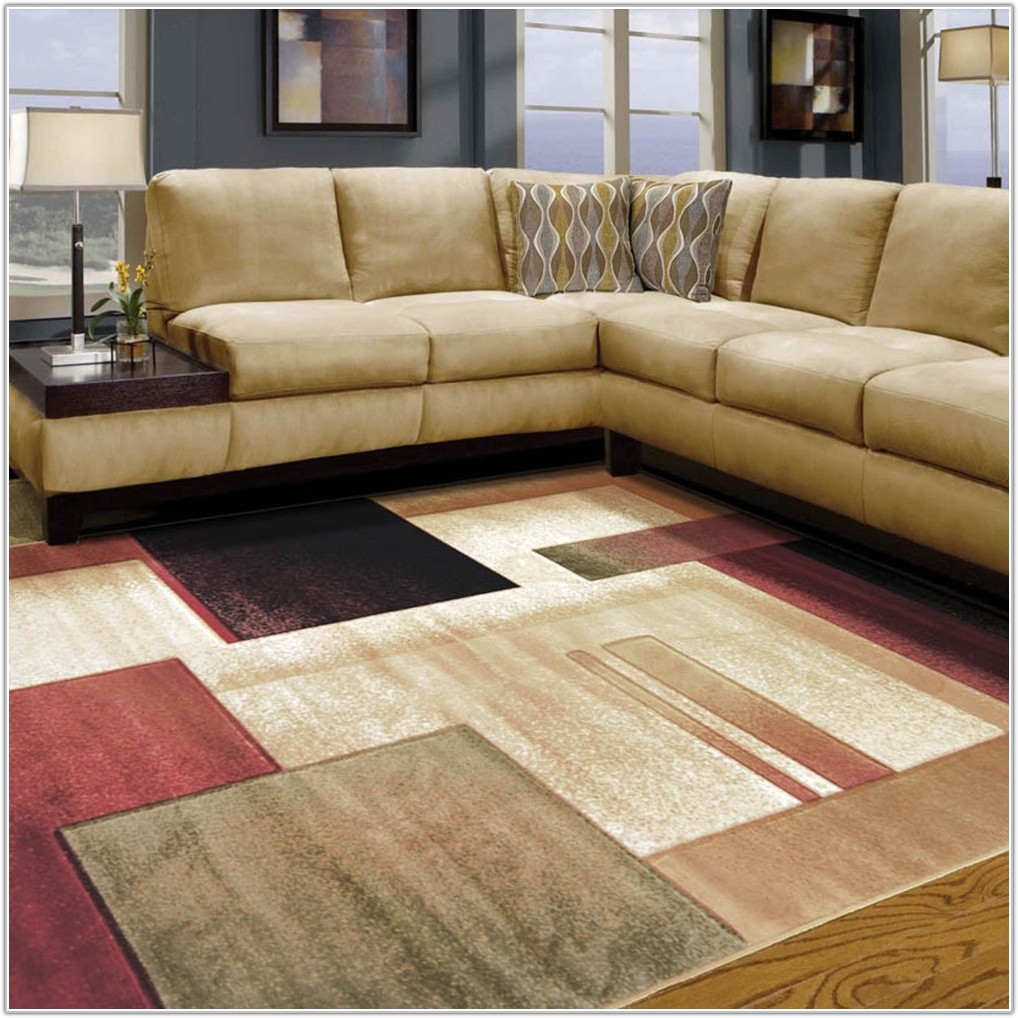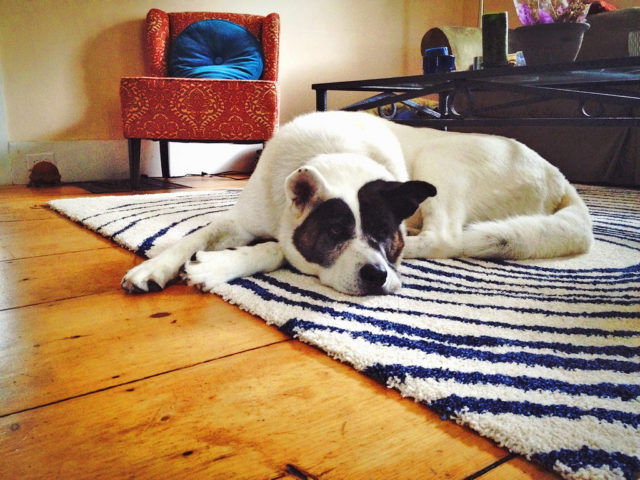Stepping into a room with gleaming hardwood floors can be a beautiful experience. But sometimes, that pristine look can feel a bit too sterile, lacking the warmth and personality that a well-placed rug can bring. I remember the first time I saw this dilemma in action. My friend, a minimalist at heart, had just moved into a stunning apartment with beautiful hardwood floors throughout. But the bare space felt cold and uninviting. It was as if the room needed a hug, a bit of softness to make it feel like home. That’s when I realized the power of rugs on hardwood floors: they bridge the gap between style and practicality, bringing a touch of personality and comfort to any space.

Image: www.keamestudio.com
This article delves into the world of rugs on hardwood floors, exploring the pros and cons, answering your burning questions, and providing expert advice on choosing the perfect rug for your home. Whether you’re a design enthusiast or simply looking to enhance the coziness of your home, this guide will equip you with the knowledge you need to make an informed decision.
The Pros and Cons of Rugs on Hardwood Floors
The decision of whether or not to put rugs on your hardwood floors is a personal one. It depends on your style, your needs, and the overall aesthetic you’re aiming for. But before you make a decision, it’s helpful to understand the advantages and disadvantages of incorporating rugs into your hardwood floor design.
Pros:
- Adds warmth and comfort: A soft, inviting rug can transform a cold, hard floor into a cozy sanctuary. It’s especially beneficial in high-traffic areas like living rooms and bedrooms, creating a more comfortable experience for bare feet.
- Enhances a room’s aesthetic: Rugs can be used to define spaces, add color, and create visual interest. They can tie together a room’s design elements, such as furniture and artwork, and create a more cohesive and stylish look.
- Protects hardwood floors: Rugs help protect your hardwood floors from scratches and wear and tear, especially in areas with high foot traffic. This is especially relevant for families with young children or pets who might be prone to spills and accidents.
- Sound absorption: Rugs can effectively minimize noise levels, absorbing sound and creating a more peaceful and quieter environment by reducing footfall noise and echoes.
- Increased versatility: Rugs allow you to change the look of your room easily and affordably. By simply swapping out a rug, you can refresh your entire space and create a completely different vibe without making major renovations.
Cons:
- Can obscure the beauty of your hardwood floors: For some, hiding the elegance of their hardwood floors beneath a rug might feel like a waste. If you’ve taken pride in the look of your hardwood floors, you might prefer a minimal rug approach or even go rug-free.
- Can be a dust and allergen trap: Rugs can trap dust, pollen, and other allergens, which can be a challenge for people with allergies or sensitivities. Regular vacuuming and cleaning are crucial for maintaining a healthy environment.
- Potential for tripping hazards: Depending on the size and placement of the rug, it can create a tripping hazard, especially for young children or elderly individuals. It’s essential to choose a rug that fits the space well and has a secure grip on the hardwood floor.
- Can be challenging to clean: Depending on the type of rug and the material it’s made from, cleaning can be a chore. Some rugs may require professional cleaning, while others can be cleaned at home with the right tools and techniques.

Image: log-homes.thefuntimesguide.com
Choosing the Right Rug for your Hardwood Floors
Once you’ve weighed the pros and cons and decided that rugs are right for your home, the next step is selecting the perfect rug for your hardwood floors. There are many factors to consider, including size, shape, color, material, and texture. Ultimately, the best rug is one that complements your existing decor and caters to your personal preferences.
Here are some tips and advice from interior design experts:
Size Matters:
A common mistake people make when buying rugs is choosing one that’s too small. To make your space feel balanced and visually appealing, your rugs should be large enough to extend beyond the edges of your furniture.
Shape Options:
Rectangular rugs are the most popular choice for hardwood floors due to their versatility and ease of placement. However, don’t shy away from exploring round, oval, or even geometric shapes for a more unique and artistic touch.
Color and Pattern:
When it comes to color and pattern, the key is to choose a rug that complements your existing decor and flooring. Neutral colors create a calming and sophisticated atmosphere, while vibrant hues can add a pop of personality and fun. If you’re unsure, a simple patterned rug with muted colors can be a safe and stylish choice.
Material Makes a Difference:
The material of your rug will affect its durability, texture, and overall feel. Wool is a popular choice for its natural beauty, durability, and ability to regulate temperature. Silk exudes elegance and luxury, while cotton offers a more casual and affordable option. Synthetic fibers, like nylon and polyester, are known for their durability and stain resistance.
Consider Your Lifestyle:
If you have pets or small children, opt for a rug that’s durable, stain-resistant, and easy to clean. For high-traffic areas, a rug with a thick pile can provide added comfort and protection. And if you want to create a more elegant and formal look, a rug with a low pile may be more appropriate.
Expert Tip: Embrace the Power of Layering
Layering rugs is a stylish and practical way to add warmth, texture, and visual interest to your hardwood floors. You can create a layered effect by placing a larger rug beneath a smaller rug or by using a runner or area rug in a high-traffic area. This allows for visual contrast and texture while still showcasing the beauty of your hardwood floor underneath.
Frequently Asked Questions about Rugs on Hardwood Floors
Here are some of the most common questions about rugs on hardwood floors that we receive:
Q: How do I prevent my rug from slipping on hardwood floors?
A: There are a few effective methods for preventing rug slippage on hardwood floors. A non-slip rug pad placed beneath the rug will create a secure grip, ensuring stability and reducing the risk of accidents. You can also use rug tape or grippers, which adhere to the underside of the rug and the floor, providing additional friction.
Q: What are the best rugs for pets and children?
A: When selecting a rug for a home with pets and children, it’s crucial to choose one that’s durable, stain-resistant, and easy to clean. Materials like nylon and wool are known for their resilience. Additionally, rugs with a tight weave and a low pile will make it harder for pet hair and dirt to accumulate.
Q: How often should I clean my rugs on hardwood floors?
A: The frequency of cleaning your rugs depends on several factors, including foot traffic, pet ownership, and the presence of allergies. Vacuuming weekly is generally recommended to remove dust, dirt, and pet hair. However, deep cleaning with a professional cleaner might be necessary for heavily soiled rugs or those with specific stains.
Rugs On Hardwood Floors Yes Or No
Conclusion
Rugs on hardwood floors can elevate the style and comfort of your home, adding warmth, personality and, ultimately, a sense of completeness. Remember to choose your rug wisely, with size, shape, color, material, and texture carefully considered. Embrace the power of layering to create visual interest and a sense of dimension. This article has highlighted the benefits and drawbacks, provided expert tips, and answered common questions. Now that you’re armed with this knowledge, are you ready to make the perfect rug choice for your hardwood floors and create a space you truly love?





